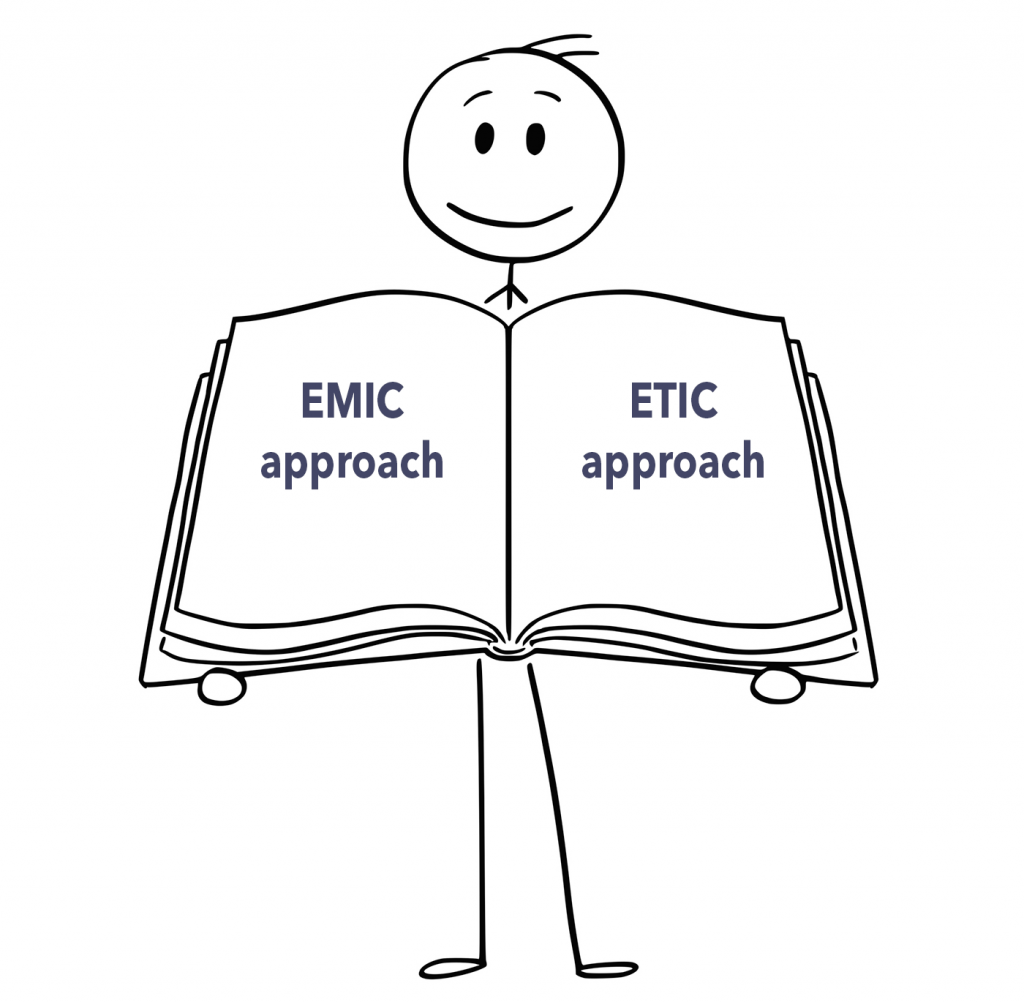
The impact of cross-cultural management on a behavioral training tool
Those involved in the field of Learning & Development are well aware of the central role that the socio-cultural context plays in the learning processes.
Particularly when dealing with soft skills and improving interpersonal interactions, it is necessary to bear in mind that perceptions, feelings and practices of any trainee are always filtered by the culture to which he belongs.
Here at SkillGym, we are well aware of this challenge. SkillGym is a system based on Digital Role Play that aims to improve user behavior in real life. This is done by involving the user in the simulation of a Critical Conversation with one or more characters and evaluating the quality of his observable behaviors put into practice during the conversation.
It is therefore clear that the socio-cultural context affects at least four structural elements of a Digital Role Play:
- The verbal modes in which behaviors are expressed
- The verbal reaction of the counterpart on the basis of the way the behaviors have been put into practice
- The non-verbal reactions of the counterpart
- The physical appearance of the counterpart
The interpretation of a culture: emic and etic approaches
The main question of this article boils down to this: what should be done to ensure that a Digital Role Play developed to be used in a certain local context can be used in different countries, not just with regard to the geographic distance, but also with consideration of ethnographic and social factors?
This question is best answered by first introducing some theoretical concepts.
Behavioral sciences identified two different approaches to understanding the role of cultures:
- EMIC approach: it reflects an “inside” perspective and it describes a behavior from the point of view of a person within a specific culture
- ETIC approach: it reflects an “outside” perspective and it attempts to describe differences across cultures in terms of general and external standards
It clearly emerges that the etic approach has a positivist perspective and tends to find the cultural categories universally applicable to every local context.
The emic approach instead has a postmodernist and interpretative matrix, and acts from within a specific context to identify its characterizing traits.

What is a localization?
The difference between the emic and etic approaches helps to answer our question: what does it mean to localize a behavioral Digital Role Play?
While developing new contents, the SkillGym methodologists start from an etic approach: they identify the universal categories that underlie a behavior common to every culture.
While developing new contents, the SkillGym methodologists start from an etic approach: they identify the universal categories that underlie a behavior common to every culture.
For example, elements such as active listening, engagement of people, and results orientation are key factors required of managers around the world regardless of nationality.
Once these cross-cultural elements have been defined, the development of the Digital Role Play will follow an emic approach:
- Writing the texts or text options from which users select, while taking into account the specific way in which the user’s reference culture puts into practice that behavior
- Defining the possible answers that the counterpart is going to consider the typical way in which an individual belonging to the reference culture reacts to behaviors acted by the user
- Identifying an actor to interpret the role of the counterpart, who has consistent ethnographic characteristics
- Directing the actor’s acting so that his tone of voice and his non-verbal language express the appropriate moods in the most appropriate way to the local context
Now, let’s imagine that a digital role developed to be used in the Anglo-Saxon area should be localized in the Middle East.
The operation will need to keep the cross-cultural textual structures and to realign what is relevant to the specifics of the new context:
- Translating texts in the local language
- Modifying them according to the cultural reference
- Identifying an actor who reflects the linguistic and ethnographic features
- Making new video footage with a new actor who will act out the scripts with an expressiveness consistent with his own culture
The result will be a new SkillGym simulator, coherent with the new context, measuring and training the same behaviors and soft skills as the initial version of that role play.
The necessary attitude to carry out such an operation recalls Derrida’s Deconstructionism. According to this theory, the meaning of a text is not given a priori, but is subject to multiple successive interpretations.
The textual canvas of a Digital Role Play must be deconstructed and reworked through an emic interpretation of the local culture.
The impact of the local culture on the verbal language
The social dynamics of a local culture are reflected in work life and have a profound impact on the relational modes that are put into practice during a business conversation.
Let’s take a look at some practical examples of the consequences that these specific aspects have on verbal language.
In China, individual employees can see their work as meaningful when they are garnering support from their managers rather than from their peers.
A Leader who provides precise indications and communicates a sense of authority will tend to have a more positive effect than in Western cultures, where employees prefer to have the opportunity of creating networks of relationships with their co-workers and taking part in decision-making processes.
During the process of localization of a Digital Role Play aimed to train managers in the relationship with their collaborators, the forms of communication expressed in the text must take into account these specific cultural aspects.
For instance, if the localization is intended for a Central European country such as Germany, the optimal conversation style should include verbal terms that render a sense of openness and participation.
In contrast, the same conversation localized in China will use direct expressions and a top-down approach.
Another classic example of the application of cross-cultural values is the use of cultural metaphors. Metaphorical expressions are quite useful in understanding how a society makes its own universal categories.
In Swedish society, harmony with nature and the ability to live with the strictly necessary are considered fundamental elements for the development and well-being of the individual.
Values such as self-awareness, empowerment and resilience can be recalled through metaphors that recall a spartan life in the woods far from technological comfort.
Body and expressions
In addition to verbal language, nuances in non-verbal forms of communication must also be considered in the localization of a Digital Role Play. The same body posture, the same facial expression, can express very different attitudes according to the cultural context in which we find ourselves.
The same body posture, the same expression of the face, can express very different attitudes according to the cultural context in which we find ourselves.
In Russia, open demonstration of emotions is an integral part of building trustworthy relations. While playing a behavioral simulator like SkillGym, a Russian user will expect his virtual counterpart to express emotions freely and openly.
On the other hand, when it comes to a non-verbal expression, he would prefer to experience an underacted reaction.
Nevertheless, even the counterpart’s outfit and his physical appearance are elements to be carefully considered while localizing the role play.
In Brazil, sensuality as a business characteristic is related to charisma. For a business professional, presenting himself in an appealing manner is very important.
The way he dresses, talks, and looks at the counterpart are prerequisite to success.
In the United States, casual dress and an informal approach are perceived as a demonstration of a pragmatism and a results-driven attitude.

How we localize
The SkillGym team has developed a structured process to localize a Digital Role Play as efficiently as possible.
Starting with the reference text, the content manager at SkillGym identifies and characterizes as “modifiable” those elements that are closely linked to the starting context and which therefore will have to be reworked to be adapted with the new context.
Such elements can be, for example, cultural references, idiomatic expressions, appearance and age of the character, interests and family status of the character.
The text, enriched by these indications, is then translated into the reference language. These elements are then analyzed with the help of a local subject matter expert and the most relevant way to rework these elements in the new context is identified.
Thanks to the work carried out, the text will be credible and adapted to the new culture, but the conversation plot will always revolve around the application of the observable behaviors of the original version.
Once this is done, the entire text is translated into the local language.
An actor is then selected who has the appropriate ethnographic and linguistic characteristics to interpret the character.
The video is then shot based on the new scripts. During filming, the local subject matter expert verifies that the expressions of the actor’s body express the correct mood and attitude in the way they are normally expressed in the local culture.
Anthropologist Clifford Geertz used the term anthropopoiesis (from ancient Greek anthropos = man, poiesis = construction) to define the process of the cultural construction of an individual as a part of a social interaction.
It is an expression that evokes a rebirth, a state of transition through a cultural manipulation that makes an individual be primordial and indefinite to a member of a social context.
The location of a SkillGym simulator can be seen as the result of an anthropopoietic process: a re-elaboration that allows it to be recognized and codified by a specific ethnocultural area.


An English-based SkillGym Digital Role Play and its Arabic localized version
More than a localization: adaptation
Sometimes the elements to be modified may be deeper than those seen so far. In fact, the original Digital Role Play could refer to products, conditions or practices that are not applied to the local context.
The modification of these elements is called Adaptation and it’s typically carried out at the request of multinational companies that have adopted SkillGym in a country (typically the one in which the headquarter is located) and for which content has been developed revolving around product lines, corporate terminology or regulatory frameworks that are not used in other countries.
The adaptation process follows the same steps as the localization, but it requires a deeper level of work by the SkillGym Content Manager.
The modified elements, in fact, have a greater impact on the course of the story, so the Content Manager will have to rework these elements and establish what impacts these changes have on the story as a whole. As a result of this analysis, the plot will require a partial rewrite.
In any case, the structural elements at the base of the original version remain unchanged: the conversation phases, observable behaviors and applied skills.
The benefits for corporations
Global organizations increasingly need to create new forms of collaborations. The main challenge of an L&D department is to develop competence models that are universally acceptable, but at the same time, can be understood and put in place by the company’s employees all around the world.
Companies that adopt localized versions of Digital Role Play by SkillGym have the guarantee of being able to distribute an instrument that trains all users according to a single model of skills –centralized and cross–cultural– to all their branches around the world.
Companies that adopt localized versions of Digital Role Play by SkillGym have the guarantee of being able to distribute an instrument that trains all users according to a single model of skills -centralized and cross-cultural- to all their branches around the world.
Each country will have at its disposal a version of the role play built according to the specifics of the local culture.
The result is a powerful tool that allows us to understand how behavioral models and common skills must be put into practice in our actual daily context, all thanks to a realistic and immersive experience.
At the same time, the different countries have the guarantee that the reference model is developed in such a way as to foster local ethnocultural characteristics, thus ensuring the trainees an authentic and contextualized conversation experience within their personal experience.
The effectiveness is maximized because it takes a central model, theoretical and developed externally according to an etic approach and applies it to concrete and personalized references.
Everything is done by applying an industrialized development process –centralized and controllable- every step of the way.
Moreover, thanks to the adaptation activity, SkillGym also allows for references to the market and to the business methodologies of specific regional branches to be modified, with a lower economic impact than the cost of developing a Digital Role Play from scratch.
Did you find this article interesting? Take a look at our other articles to learn more about our methodology, case studies and scientific papers.
And if you want to test out SkillGym, please book a 1-hour discovery call here.
Bibliography
-
Chhokar, J.S. et al. (2007). Culture and Leadership Across the World: The GLOBE Book of In-Depth Studies of 25 Societies. New York: Psychology Press.
-
Derrida, J. (1976). Of Grammatology. Baltimore & London: Johns Hopkins University Press.
-
Geertz, C. (1965). The Transition to Humanity, in S. Tax, Horizons of Anthropology. London: Allen and Unwin.
-
Geertz, C. (1973). The Interpretation of Cultures. New York: Basic Books.
-
Gehrke, B. and Claes, M. (2013). Global Leadership Practices. New York: Palgrave Macmillan.
-
Morris, M. et al. (1999). Views from Inside and Outside: Integrating Emic and Etic Insights about Culture and Justice Management in Academy of Management Review, 24 (4).


